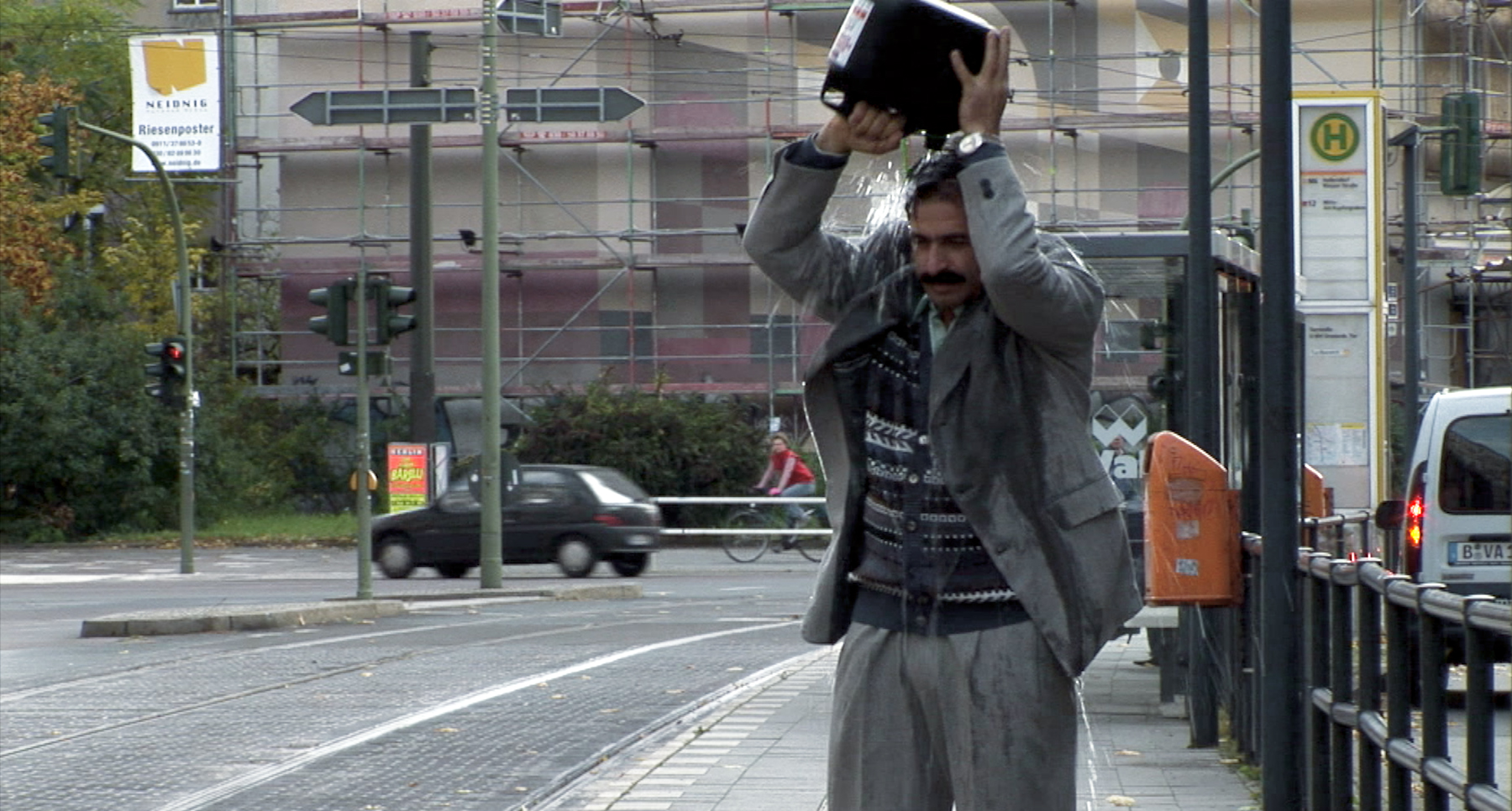
video still
Mehmet, 2005
Full HD, 01:19 min., Stereo, non-Dialogue
Written, directed, and performed: Shahram Entekhabi
Camera: Arne Hector
...
Semiotics of a Migrant Man Located in Germany
...
Doris Berger (...) Entekhabi’s figure may be compared with the alter egos of Chaplin and Tati, who stand out visually as a consequence of their old-fashioned clothing and accessories, emphasising their difference to the dominant social environment. The Duden defines the expression alter ego as “the other, the second ego” but also as a “very close friend”. In film and literature, the concept is often used for a second personality adopted by an individual; one that usually displays different character traits to the actual, the “real ego”. The alter ego of the guest-worker offers Entekhabi the possibility to relate changes in the world of work to his own experiences as a migrant in Germany.But it is no longer possible to restrict the development of migration to a few ethnic groups, and the social picture in Germany has become more complex and varied, together with the accompanying prejudices and clichéd notions concerning individual cultures. Shahram Entekhabi reflects on this by differentiating his figure of the migrant far more, abandoning his alter ego. In the most recent video works “Miguel”, “Mehmet” and “Mladen”, or also in “Islamic Star” (all 2005), the artist slips into a range of different male roles and ethnic backgrounds; usually within an urban environment. The first names in the titles already point to different origins, which Entekhabi expounds with his now constantly changing outfit and behaviour.
Through the embodiment of diverse figures in his works, Shahram Entekhabi adopts manifold attributes of an actual or presumed state of “being different”, making these visible by means of role play in public space. He employs clichéd imaginary notions of migrants, which are charged with additional content through images in the media. These can be deciphered on the basis of clothing, accessories and codes of behaviour. With regard to the staging of different identities that follow role models in the media, the structure of Entekhabi’s work may be compared with Cindy Sherman’s photo series Untitled Filmstills (1977-80), photographs in which the artist restages role images of women as influenced by films of the 50s and 60s. However, Shahram Entekhabi’s and Cindy Sherman’s works differ, not only in the media employed, but also in their reference to gender, historical context, and ethnic and cultural location. The images that Entekhabi uses for the figure of the migrant have a symbolic effect, and they are firmly rooted in the German cultural sphere. If the artist had lived in England or France, say, for as long as he has in Germany and had then realised his work on the figure of the migrant, this figure would probably display a different ethnic encoding. By these means, the artist simultaneously visualises his position as an insider and outsider in society; a position that he often experiences in his real life _ as a migrant from the Middle East who has lived in Germany for more than 20 years. He thus mixes the perspectives of an identity that is encoded on the basis of several cultures; a form of identity that is becoming more and more relevant in our globalised world.
Text: Doris Berger
Senior Director of Curatorial Affairs of the Academy Museum of Motion Pictures , Los Angeles, California, USA 
انتخابی هنرش را به عنوان تنها قلمرو ابراز وجود و تنها بستر قدرتساز برگزیده. او ویدئوهای ساخته شده در فضاهایشهری غربی را در برابر انسان غربی که همواره با بی اعتنایی از کنار شخصیت های اصلی اش گذاشته اند قرار داده و آنها را وادار به دیدن کرده است. ویدئویی چهارگانه از انتخابی، شخصیت های بازنمایی شده از مردان مهاجری، از اقلیت های دینی و حزبی و نژادی به نام های ملادن ( از مجرمان بالکان)، ستاره اسلامی (مسلمانی افراط گرا)، محمت (عضوی از گروه کارگران کُرد) را در فضاهای عمومی پرتردد شهری نشان می دهد. ملادن با القای حس برتری جنسیتی خود، سعی در ایجاد رعب و وحشت و جلب توجه در معابر عمومی دارد. ستاره اسلامی تسبیح زنان و بی هدف در خیابان پرسه می زند و به قصد دیده شدن در مکان هایی نامناسب توقف می کند؛ و محمت به ستوه آمده از فرط تنگناهای موجود، تن به خودسوزی در ملاعام می دهد. تنها شخصیت به تصویر در آمده در محیط بسته میگوئل5 (پارتیزانی غیرنظامی) است که با نگاه خیره به دوربین و خنده های فزاینده قصد گمراه کردن و استهزای برداشت احتمالی بیننده از هر حرکت وی به عنوان پیش درآمد عملی تروریستی دارد. حرف «م» مشترک در اول اسامی آنها دلالتگر کلماتی است که درون مایه آثار انتخابی را تشکیل می دهند: مردانگی، مسلمان، مهاجر، میدل ایست (خاورمیانه) ماینوریتی (اقلیت) و میمیکری -همگونی